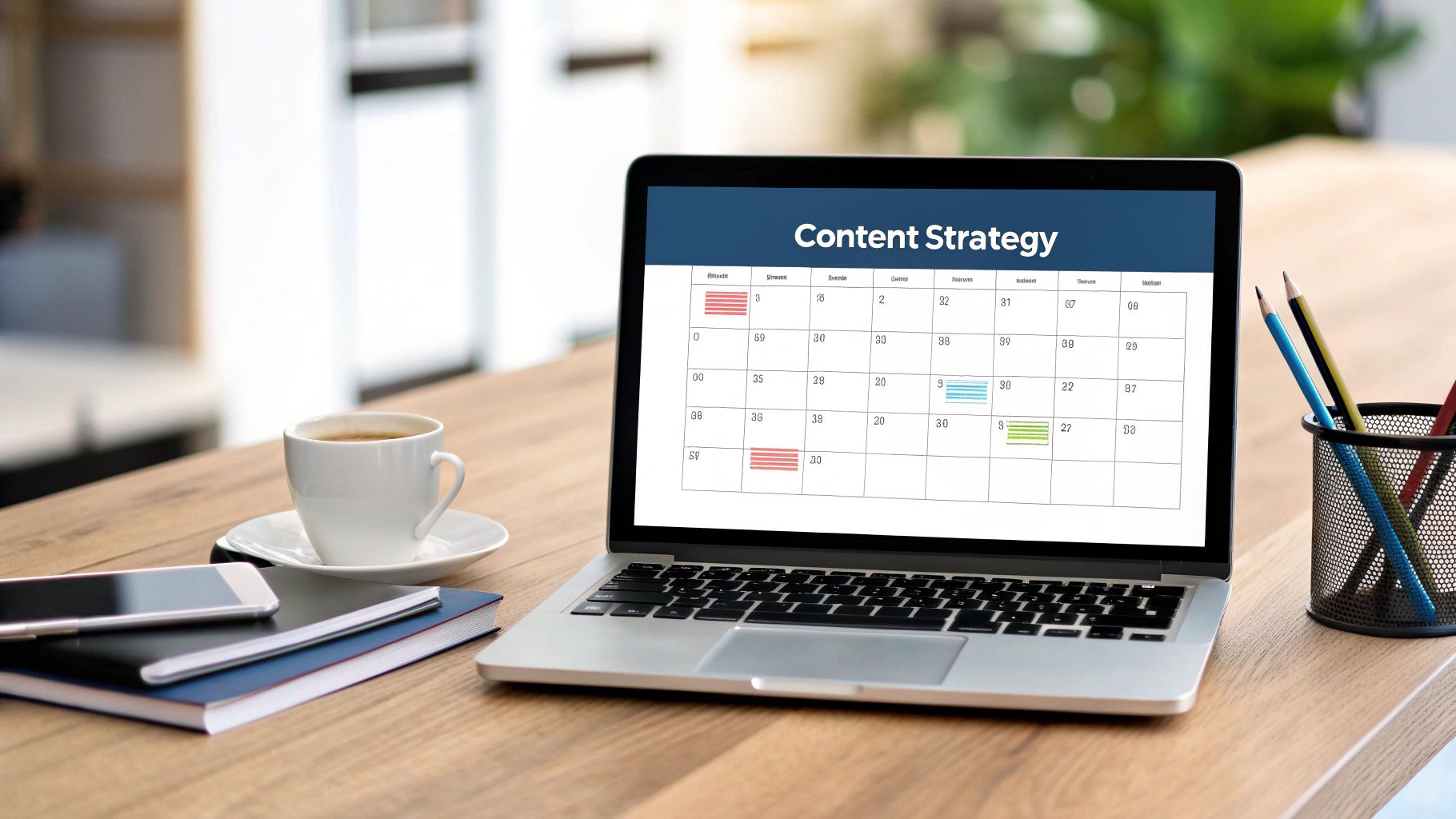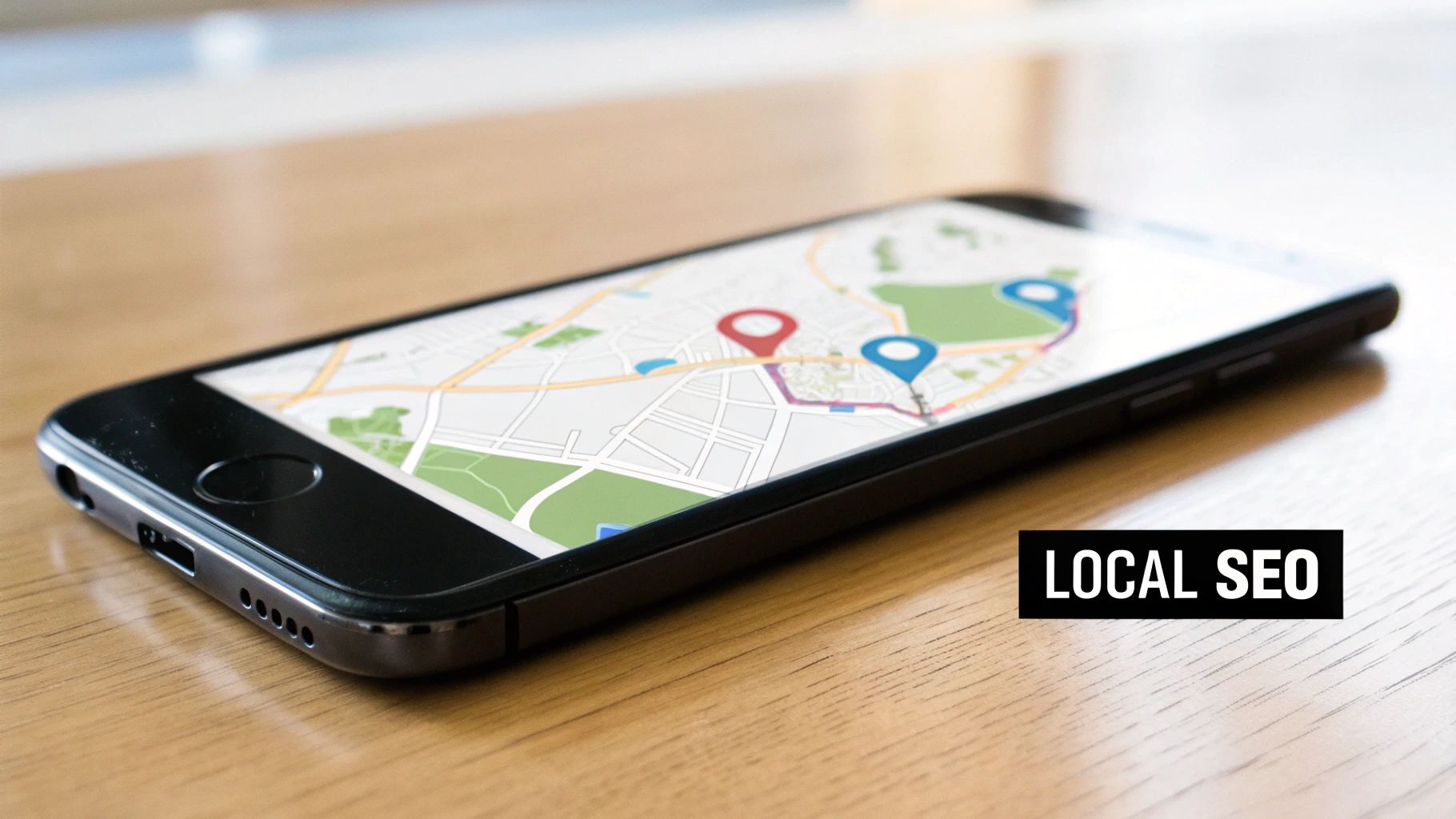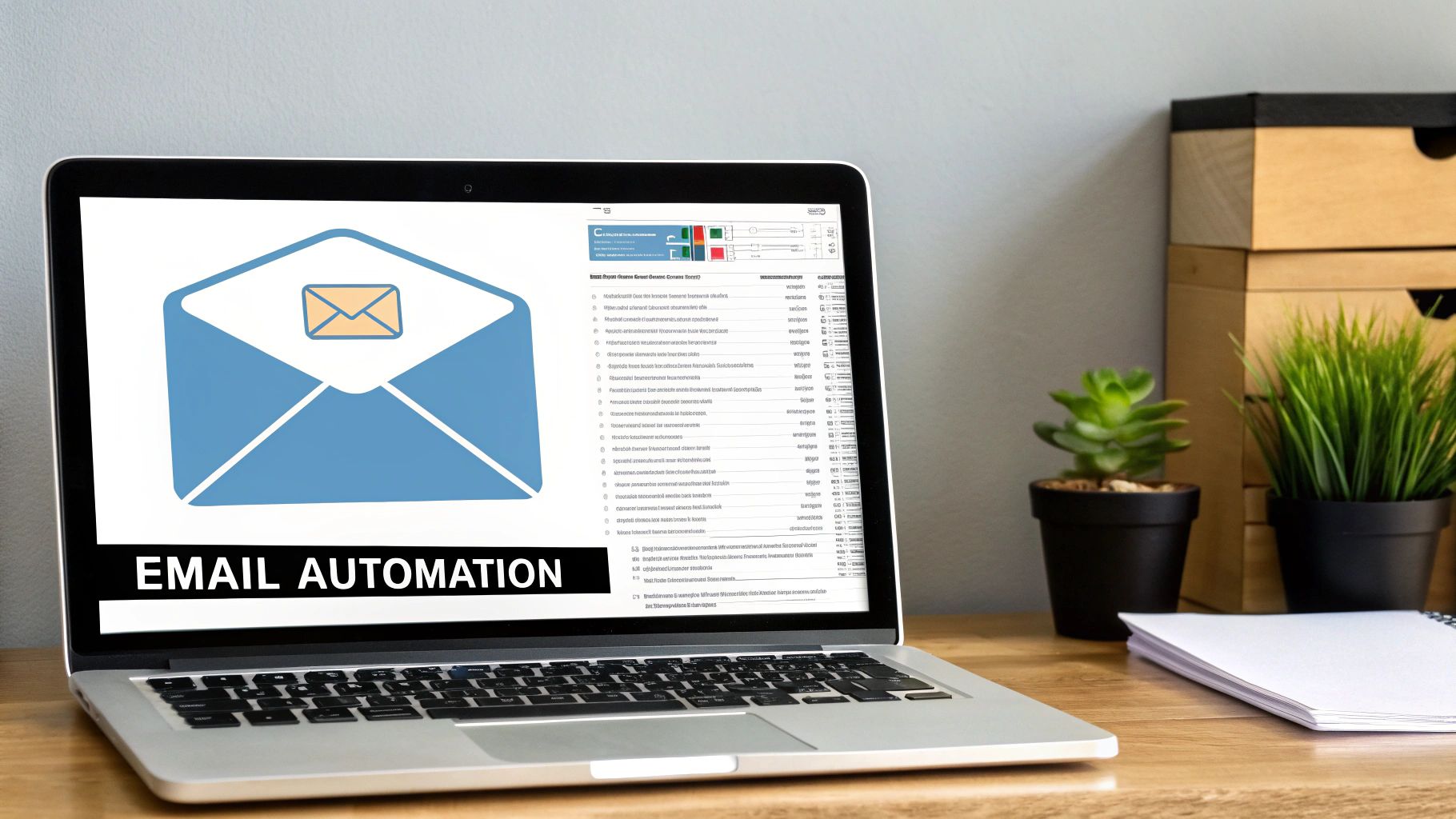
Top Digital Marketing Tips for Small Business Success 2025
Discover essential digital marketing tips for small business to boost growth and online presence in 2025. Stay ahead with expert advice!
Navigating the digital marketplace can feel overwhelming, but a powerful online presence is non-negotiable for growth. This guide cuts through the noise, providing a clear roadmap with actionable digital marketing tips for small business owners ready to see tangible results. We are moving beyond generic advice to deliver a practical blueprint you can implement immediately.
Inside, you will find specific strategies designed to elevate your brand and drive conversions. We will cover everything from mastering local SEO to attract nearby customers, to deploying smart email marketing automation that nurtures leads while you sleep. You will also learn how to optimize your website for higher conversion rates and effectively manage customer reviews to build trust and credibility. These aren't just theories; they are proven tactics for scaling your operations efficiently. For additional actionable insights, explore these essential small business digital marketing tips to further boost your online presence.
This collection of tips is engineered for impact, focusing on strategies that deliver the highest return on your time and investment. Whether you're looking to enhance your social media strategy, leverage AI-powered content tools like ViewPrinter, or optimize Google Ads, you’ll find the step-by-step guidance needed to transform your marketing from an expense into a powerful growth engine. Let's begin building your blueprint for success.
1. Content Marketing Strategy
A strong content marketing strategy is the bedrock of modern digital marketing. Instead of directly pitching your products or services, this approach focuses on creating and distributing valuable, relevant, and consistent content to attract and retain a specific audience. For small businesses, this is one of the most powerful digital marketing tips for small business because it establishes authority, builds customer trust, and ultimately drives profitable action without a massive advertising budget.

This method works by providing solutions and information your target customers are already searching for. Think of Mailchimp’s extensive library of marketing guides or Warby Parker’s blog, which offers eye health tips alongside fashion trends. These brands became go-to resources, building a loyal following that converts to customers over time.
How to Implement a Content Strategy
Getting started doesn't have to be overwhelming. Focus on a structured, customer-centric approach to see the best results.
- Create a Content Calendar: Plan your content themes and specific topics at least three months in advance. This ensures consistency and helps you align your content with seasonal trends or product launches.
- Solve Customer Problems: Your content's primary goal should be to answer your audience's most pressing questions. Use tools like AnswerThePublic or browse forums like Reddit to find out what your potential customers are struggling with.
- Repurpose and Distribute: Don't let great content die after one post. Turn a detailed blog post into a series of social media graphics, a short video, or a podcast segment. Distribute this repurposed content across every channel where your audience spends their time.
- Analyze and Optimize: Use analytics to track which content formats and topics resonate most. Double down on what works and refine what doesn’t to continuously improve your strategy's effectiveness and ROI.
2. Local SEO Optimization
For businesses with a physical location or a defined service area, mastering local search is non-negotiable. Local SEO is the practice of optimizing your online presence to attract more customers from relevant local searches on Google and other search engines. This is one of the most critical digital marketing tips for small business because it directly connects you with high-intent customers actively looking for your specific products or services in their immediate area.

This strategy is what allows a local restaurant to appear in the "pizza near me" map pack or a plumber to rank first for "plumber in Brooklyn." By optimizing for local signals, you tell search engines that your business is a relevant, trustworthy, and prominent answer for users in a specific geographic location, driving foot traffic and local sales.
How to Implement Local SEO
Dominating local search results requires a focused effort on your Google Business Profile and consistent local signals across the web.
- Claim and Optimize Your Google Business Profile: This is your most important local SEO asset. Fill out every section completely, including services, photos, hours, and a detailed business description. An optimized profile is the foundation for appearing in Google Maps and the local pack.
- Encourage and Manage Reviews: Positive reviews are a powerful ranking factor. Create a simple process to ask satisfied customers for reviews, such as sending a follow-up email with a direct link. Respond to all reviews, both positive and negative, to show you are an engaged business owner.
- Ensure NAP Consistency: Your business Name, Address, and Phone number (NAP) must be identical across all online directories and listings (like Yelp, Yellow Pages, and industry-specific sites). Inconsistencies can confuse search engines and hurt your rankings.
- Create Location-Specific Content: Develop content that is hyper-relevant to your service area. This could be a blog post about a local event you sponsored or a service page that details your work in a specific neighborhood, using keywords like "[service] in [city/neighborhood]."
3. Social Media Marketing Focus
A strategic social media marketing focus is about more than just posting updates; it's about building a community and driving growth on the platforms where your customers live online. Instead of spreading your efforts too thin across every available channel, this approach prioritizes 1-3 key platforms. For small businesses, this is one of the most effective digital marketing tips for small business because it concentrates your resources, fosters genuine engagement, and builds a loyal audience that converts.

This method works by meeting customers where they are with authentic, valuable content. Think of how Glossier built its beauty empire primarily through Instagram engagement, turning customers into brand advocates. Similarly, local bakeries use Instagram Stories to showcase daily specials, creating a sense of urgency that often leads to selling out their inventory before the day ends.
How to Implement a Social Media Focus
A focused strategy prevents burnout and delivers better results. Use these steps to build an effective and manageable social media presence.
- Choose Platforms Wisely: Select your channels based on where your target audience is most active, not your personal preference. A B2B tech company will find more value on LinkedIn, while a visual brand like a clothing boutique will thrive on Instagram and Pinterest.
- Post with Consistency: Use scheduling tools like Buffer or Hootsuite to maintain a regular posting cadence. Consistency keeps your brand top-of-mind and signals to platform algorithms that your account is active and relevant.
- Engage Authentically: Social media is a two-way conversation. Respond to comments and messages promptly, ask your audience questions, and share user-generated content to humanize your brand and build a strong community. This engagement is key to improving brand awareness.
- Track Meaningful Metrics: Move beyond follower count and focus on metrics that indicate genuine interest, like engagement rate, reach, and website clicks. These numbers provide a clearer picture of your strategy's impact on business goals.
4. Email Marketing Automation
Email marketing automation is a powerful system for nurturing leads and customers through pre-built email sequences triggered by specific user actions. Instead of manually sending one-off campaigns, this approach delivers personalized messages at scale, building strong customer relationships over time. For small businesses, this is one of the most effective digital marketing tips for small business because it saves time, increases relevance, and drives conversions on autopilot.

This method works by setting up "if this, then that" rules for your email list. For example, Dollar Shave Club uses an automated onboarding sequence to educate new members on product benefits, while Airbnb sends personalized travel recommendations based on a user's booking history. These automated touchpoints feel personal and timely, significantly boosting engagement and customer loyalty.
How to Implement Email Automation
Getting started is simpler than it sounds. Begin with the most impactful automations first and expand your system over time.
- Start with a Welcome Series: Create a simple 3-5 email sequence for new subscribers. Use it to introduce your brand, set expectations, and provide immediate value, such as a discount or a popular piece of content.
- Segment Your Audience: Group your subscribers based on their behavior, like purchase history, engagement level, or interests. This allows you to send hyper-targeted messages that resonate much more effectively than a generic blast.
- Recover Abandoned Carts: If you run an e-commerce store, an abandoned cart email is a must-have. A simple, timely reminder can recover a significant percentage of otherwise lost sales by nudging customers to complete their purchase.
- Optimize and Clean Your List: Regularly review the performance of your automated emails and A/B test subject lines to improve open rates. It's also crucial to periodically remove inactive subscribers to maintain a healthy sender reputation and improve overall deliverability. Learn more about marketing automation best practices on viewprinter.tech.
5. Google Ads for Small Business
While organic growth is crucial, Google Ads offers an immediate way to capture high-intent customers actively searching for your solutions. This pay-per-click (PPC) platform allows you to place ads at the top of search results, putting your business in front of people at the exact moment they need you. For small businesses, this is one of the most effective digital marketing tips for small business because it drives qualified traffic and generates leads and sales with a measurable, controllable budget.
This strategy works by targeting specific keywords your potential customers are using. Think of a local plumber bidding on "emergency plumber in Miami" to generate immediate service calls or an e-commerce store using Shopping ads to display product images and prices directly in search results. These ads connect your business with ready-to-buy customers, delivering a powerful and immediate return on investment.
How to Implement a Google Ads Strategy
A strategic approach is key to maximizing your ad spend and avoiding common pitfalls. Focus on precision and relevance to achieve the best results.
- Start with Exact Match Keywords: Begin with a small set of highly specific, exact match keywords to control your budget and ensure your ads are shown to the most relevant audience. This minimizes wasted spend on broad, unqualified searches.
- Use Negative Keywords Aggressively: Actively build a list of negative keywords to prevent your ads from appearing for irrelevant searches. For example, a premium shoe brand might add "cheap" or "free" to its negative list to filter out bargain hunters.
- Create Dedicated Landing Pages: Send ad traffic to a custom landing page that directly matches the ad's message and offer, rather than your homepage. This consistency dramatically improves conversion rates.
- Set Up Conversion Tracking First: Before spending a single dollar, ensure conversion tracking is properly installed. This is the only way to measure what’s working and accurately calculate your return on ad spend (ROAS).
6. Customer Review Management
A proactive customer review management strategy is a non-negotiable part of modern digital marketing. This involves systematically encouraging, monitoring, and responding to online reviews on platforms like Google, Yelp, and Facebook. For small businesses, this is one of the most critical digital marketing tips for small business because reviews directly influence purchasing decisions, build social proof, and significantly impact local SEO rankings.
This strategy works by treating online feedback as a direct line of communication with both current and potential customers. Think of a local restaurant that uses feedback from a negative review to refine a menu item or a home service company that showcases glowing five-star reviews on its website as testimonials. These actions build trust and demonstrate a commitment to customer satisfaction that attracts new business.
How to Implement a Review Management Strategy
A structured approach ensures you build a positive online reputation and turn feedback into a powerful marketing asset.
- Ask at the Right Time: Automate a simple email or text message to send to customers a few days after their purchase or service completion. Timing is key; ask when the positive experience is still fresh in their minds.
- Respond to Every Review: Make it a policy to respond to all reviews, both positive and negative, within 24-48 hours. Thank positive reviewers and address negative feedback professionally by offering a solution or taking the conversation offline.
- Leverage Positive Feedback: Turn your best reviews into marketing gold. Share screenshots of five-star reviews on your social media profiles, add them to your website's homepage, or include them in your email newsletters as social proof.
- Train Your Team: Ensure every employee understands that their performance directly impacts customer reviews. Empower them to deliver exceptional service and teach them how to gently encourage satisfied customers to leave feedback.
7. Website Conversion Rate Optimization
Driving traffic to your website is only half the battle; converting that traffic into customers is where the real growth happens. Conversion Rate Optimization (CRO) is the systematic process of improving your website to increase the percentage of visitors who take a desired action, like making a purchase or filling out a form. This is one of the most critical digital marketing tips for small business because it maximizes the value of your existing audience without needing to spend more on attracting new visitors.
This method focuses on understanding how users navigate your site, what actions they take, and what stops them from converting. For example, Barack Obama’s 2008 campaign famously raised an additional $60 million by A/B testing different images and button text on their donation page. Similarly, many service businesses have doubled their lead generation simply by simplifying their contact forms from ten fields down to three.
How to Implement a CRO Strategy
Getting started with CRO involves a methodical approach of testing and learning. Focus on high-impact changes that directly address user friction.
- Analyze High-Impact Pages: Begin by identifying your most important pages, such as your homepage, product pages, or landing pages with the highest traffic. Use analytics to find where users drop off and form a hypothesis about why.
- Test One Element at a Time: To get clear, reliable data, change only one variable per test. For instance, test a new headline, a different call-to-action button color, or a revised form layout, but not all at once.
- Gather User Feedback: Use surveys, heatmaps, or session recording tools to understand the "why" behind user behavior. This direct feedback often reveals pain points you would otherwise miss, such as confusing navigation or a broken link.
- Prioritize Mobile and Speed: With a majority of traffic coming from mobile devices, ensure your website is fully responsive and loads quickly. A slow, frustrating mobile experience is a guaranteed way to lose potential conversions before they even begin.
8. Marketing Analytics and Data Tracking
Operating without data is like driving with your eyes closed. Marketing analytics and data tracking involve implementing systems to measure, analyze, and optimize your performance across all digital channels. For any small business, this is one of the most critical digital marketing tips for small business because it replaces guesswork with evidence, showing you exactly what’s working, what isn’t, and where to invest your budget for maximum returns.
This data-driven approach allows you to understand the complete customer journey. For example, an e-commerce store can track how a user discovers a product on social media, visits the website, and eventually makes a purchase. Similarly, a local service business can measure exactly how many phone calls or form submissions originated from a specific Google Ad, proving its direct value.
How to Implement Marketing Analytics
Getting started with analytics is about focusing on actionable metrics that align directly with your business goals, not just vanity numbers.
- Set Up Foundational Tools: Begin with Google Analytics 4 (GA4) and Google Tag Manager. These free tools provide a comprehensive framework for tracking website traffic, user behavior, and specific conversion events without needing to edit code constantly.
- Define Key Conversion Goals: Identify what actions matter most to your business. This could be a completed purchase, a lead form submission, a newsletter signup, or a phone call. Set these up as conversion goals in your analytics platform.
- Use UTM Parameters for Campaigns: To track the effectiveness of individual campaigns (like an email newsletter or a specific social media ad), append UTM parameters to your links. This tells you exactly which sources are driving traffic and conversions. You can learn more about understanding social media analytics to see how this applies.
- Create Actionable Dashboards: Build custom dashboards that display your most important key performance indicators (KPIs) at a glance. Focus on metrics like cost per acquisition (CPA), conversion rate, and customer lifetime value (CLV) to make informed decisions.
Digital Marketing Tips: 8-Point Strategy Comparison
| Strategy | Implementation Complexity 🔄 | Resource Requirements ⚡ | Expected Outcomes 📊 | Ideal Use Cases 💡 | Key Advantages ⭐ | |--------------------------------|-----------------------------------------------|--------------------------------------|------------------------------------------------------------------|----------------------------------------------------------|-----------------------------------------------------------| | Content Marketing Strategy | Medium - requires planning, creativity | Moderate - 3-10 hrs/week, low budget | Builds brand authority, organic traffic, long-term customer loyalty | Small businesses wanting sustainable growth through content | Cost-effective, builds trust, SEO benefits | | Local SEO Optimization | Medium - ongoing profile and citation management | Moderate - continuous effort | Increased local visibility, foot traffic, high-intent customers | Businesses serving local markets | Targets ready-to-buy local customers, mobile-first | | Social Media Marketing Focus | High - daily engagement, content creation | High - time-intensive, platform tools | Brand awareness, community engagement, viral potential | Brands targeting active social platform audiences | Direct customer interaction, cost-effective branding | | Email Marketing Automation | Medium - setup of automated workflows | Moderate - email tools subscription | High ROI, scalable customer nurturing, personalized engagement | Businesses with existing contact lists seeking automation | Highest ROI, scalable, direct communication | | Google Ads for Small Business | High - campaign setup, bid management | High - ad spend starting ~$300/month | Immediate leads, targeted traffic, measurable ROI | Businesses needing fast results & lead generation | Immediate visibility, pay-per-click, detailed tracking | | Customer Review Management | Medium - monitoring and responding regularly | Low to moderate - tools, time | Enhanced reputation, improved local SEO, customer trust | Businesses reliant on online reputation and reviews | Builds credibility, influences purchase decisions | | Website Conversion Rate Optimization | Medium to High - testing, technical implementation | Moderate - tools and expertise | Increased conversion rates, better ROI from existing traffic | Websites aiming to maximize existing traffic value | Improves revenue without extra traffic, user insights | | Marketing Analytics and Data Tracking | High - setup and interpretation complexity | Moderate to high - tools, expertise | Data-driven decisions, optimized marketing spend | Businesses with multi-channel digital marketing | Enables precise optimization, ROI tracking |
Putting Your Plan Into Action
Navigating the digital marketing landscape can feel overwhelming, but the journey to success is built one strategic step at a time. We've explored a powerful set of strategies, from establishing a dominant local presence with Local SEO to fostering long-term relationships through Email Marketing Automation. The key isn't to implement all eight of these tips overnight. Instead, the path to mastery lies in methodical, consistent execution. Your goal is to create a sustainable marketing engine, not a short-lived campaign.
The most successful small businesses treat their marketing as an integrated system. Your Content Marketing Strategy fuels your social media channels and email newsletters. Your Customer Review Management provides invaluable social proof that enhances your Google Ads and website. Each element supports the others, creating a cohesive and powerful brand experience for your audience. This interconnected approach transforms isolated tactics into a compounding force for growth.
Your Actionable Next Steps
To truly leverage these digital marketing tips for small business, you must move from learning to doing. The transition from theory to tangible results begins now. Here is a simple, actionable framework to get you started:
- Conduct a Self-Audit: Review the eight strategies discussed. Which one addresses your most significant business challenge right now? Is it converting website visitors? Or is it simply getting found by local customers? Pinpoint your top priority.
- Choose Your Starting Point: Select just one or two tactics to focus on for the next 90 days. If you need more local traffic, dive deep into your Google Business Profile and local keyword strategy. If your sales funnel is leaking, concentrate entirely on Website Conversion Rate Optimization.
- Define and Measure: Set a clear, measurable goal for your chosen tactic. For instance, "Increase positive Google reviews by 20% in the next quarter" or "Improve website conversion rate from 1.5% to 2%." Use tools to track your progress meticulously, as Marketing Analytics is the compass that guides all future decisions.
From Strategy to Sustainable Growth
Remember, the essence of effective digital marketing is iteration. You will test, measure, learn, and adapt. Some initiatives will deliver immediate wins, while others will require patience and refinement. The crucial element is persistence. By consistently applying these principles, you're not just chasing clicks and conversions; you are building a resilient, customer-centric brand. You are creating a direct line of communication with your audience, understanding their needs, and positioning your business as the definitive solution. This foundational work is what separates fleeting success from lasting market leadership.
Ready to supercharge your content creation and social media scheduling? ViewPrinter provides the AI-powered tools you need to implement these strategies efficiently, automating routine tasks so you can focus on growing your business. Explore how our platform can revolutionize your workflow and amplify your results at ViewPrinter.